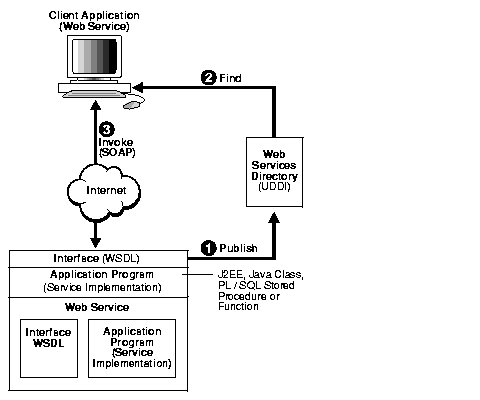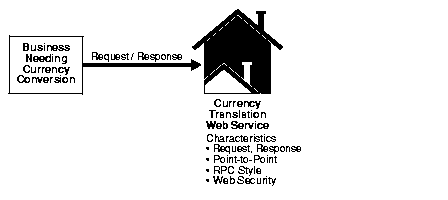Release 2 (9.0.2)
Part Number A95453-01
Home |
Solution Area |
Contents |
Index |
| Oracle9i Application Server Web Services Developer's Guide Release 2 (9.0.2) Part Number A95453-01 |
|
This chapter provides an overview of Web Services. Chapter 2, "Oracle9iAS Web Services" describes the Oracle9iAS Web Services features, architecture, and implementation.
This chapter covers the following topics:
Web Services consist of a set of messaging protocols, programming standards, and network registration and discovery facilities that expose business functions to authorized parties over the Internet from any web-connected device.
This section covers the following topics:
A Web Service is a discrete business process that does the following:
Web Services provide a standards based infrastructure through which any business can do the following:
The benefits for enterprises seeking to develop and use Web Services to streamline their business processes include the following:
The move to transform businesses to e-Businesses has driven organizations around the world to begin to use the Internet to manage corporate business processes. Despite this transformation, business on the Internet still functions as a set of local nodes, or Web sites, with point-to-point communications between them. As more business moves online, the Internet should no longer be used in such a static manner, but rather should be used as a universal business network through which services can flow freely, and over which applications can interact and negotiate among themselves.
To enable this transformation, the Internet needs to support a standards-based infrastructure that enables companies and their enterprise applications to communicate with other companies and their applications more efficiently. These standards should allow discrete business processes to expose and describe themselves on the Internet, allow other services to locate them, to invoke them once they have been located, and to provide a predictable response.
Web Services drive this transformation by promising a fundamental change in the way businesses function and enterprise applications are developed and deployed.
This e-Business transformation is occurring in the following two areas:
Web Services enables the next-generation of e-business, a customer-centric, agile enterprise that does the following:
Web Services enables enterprise applications with the following technology transformations:
This section describes the Internet standards that comprise Web Services, including:
Figure 1-1 shows a conceptual architecture for Web Services using these standards.

The Simple Object Access Protocol (SOAP) is a lightweight, XML-based protocol for exchanging information in a decentralized, distributed environment. SOAP supports different styles of information exchange, including: Remote Procedure Call style (RPC) and Message-oriented exchange. RPC style information exchange allows for request-response processing, where an endpoint receives a procedure oriented message and replies with a correlated response message. Message-oriented information exchange supports organizations and applications that need to exchange business or other types of documents where a message is sent but the sender may not expect or wait for an immediate response.
SOAP has the following features:
|
See Also:
|
The Web Services Description Language (WSDL) is an XML format for describing network services containing RPC-oriented and message-oriented information. Programmers or automated development tools can create WSDL files to describe a service and can make the description available over the Internet. Client-side programmers and development tools can use published WSDL descriptions to obtain information about available Web Services and to build and create proxies or program templates that access available services.
|
See Also:
|
The Universal Description, Discovery, and Integration (UDDI) specification is an online electronic registry that serves as electronic Yellow Pages, providing an information structure where various business entities register themselves and the services they offer through their WSDL definitions.
There are two types of UDDI registries, public UDDI registries that serve as aggregation points for a variety of businesses to publish their services, and private UDDI registries that serve a similar role within organizations.
|
See Also:
|
To understand how Web Services work, consider a currency translation service that provides businesses with up-to-the-instant currency conversion information. Figure 1-2 shows the characteristics of such a Web Service.
A business has a financial management application which needs to check the conversion rate from one currency to another currency before completing a transaction. The financial management application sends a request to the currency conversion Web Service, it is processed, and a response is returned in real-time.
Using Web Services, there are two roles to consider, the role of the publisher that develops the currency conversion Web Service, and the role of the caller, the financial management application that uses the Web Service.

The publisher develops the currency conversion Web Service; the publisher's role includes the following:
The caller is the financial management application that uses the currency conversion Web Service; the caller's role includes the following:
|
|
 Copyright © 2002 Oracle Corporation. All Rights Reserved. |
|